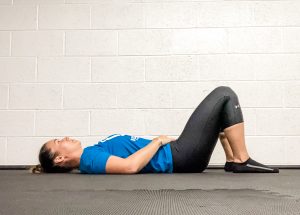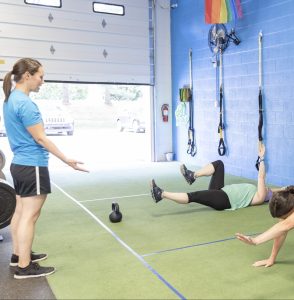One of our main philosophies here at Bent On Better is to “move well so you can move often,” and what we mean by that is to make sure that you’re doing an exercise correctly and in its best form instead of just doing it for the sake of “doing it.” Of course, we appreciate it when a member is gung-ho about starting a new exercise, but to ensure that you do not experience any injury throughout your workout, you need to be able to take a step back and re-examine if this specific technique is going to help you in the long-run.
To narrow it down, let’s talk about Compound Lifts and how having a strong “core” can help make sure you do these exercises properly and efficiently.
What is a Compound Lift?
A compound lift is an exercise that combines multiple joint movements into one larger, gross movement. Examples of compound lifts include squats, deadlifts, bench presses, bent-over rows, etc.
How you can benefit from doing Compound Lifts:
- Burn more total energy throughout the body, which helps with losing weight.
- Improve testosterone levels for men.
- Generate lean body mass.
- Strengthen your mid-section (even when you’re above 40 years old!)
Compound lifts impose high demands on “core” strength and strengthen your core every time you perform these exercises. The process is quite beautiful, but to understand and optimize the relationship between compound lifts and core strength, we must first define “core” and identify exercises (other than compound lifts) that can help make you more aware of and strengthen your core.
What is your core?
The “core” is the collection of all the muscles through your torso/mid-section that support the integrity of your spine and pelvic floor.
Figure from acefitness.org
Play on Spotify:
Some Exercises That Can Help Strengthen Your Core (and bring awareness to it)
1. The Pelvic Tilt
Start by laying down flat on the ground, on your back. Next, bend your knees and keep your feet flat on the floor. Next, tilt your pelvis inward slightly as if you’re tucking in your belly button or trying to “flip your belt buckle upwards.” You should be feeling some tension in your lower abdomen. Hold this position momentarily, then tilt your pelvis back in the opposite direction, or back to the starting position. Repeat this exercise in sets of five to ten repetitions to help develop muscle awareness and foundational core strength.
2. The Deadbug
Start by laying down f lat on the ground, on your back. Bend your knees and keep both feet flat on the floor with your arms pushed flat into the ground on either side of your body. Next, raise your knees at a 90-degree angle towards your chest, aiming to stop when your hips create a 90-degree angle as well. Then, slowly raise your arms to the ceiling, keeping your shoulders against the ground. Make sure the lower back does not hyperextend (“arch”); after all, learning how to prevent this from happening is exactly how you will strengthen the muscles of your core. Your goal is to keep your lower back in a neutral or close-to-flush position relative to the floor beneath it while you sustain the suspension of all four limbs in the air. This is the starting position for the dead bug. You can practice assuming this position momentarily while maintaining regular breathing in sets of five to ten repetitions to help develop muscle awareness and foundational core strength.
lat on the ground, on your back. Bend your knees and keep both feet flat on the floor with your arms pushed flat into the ground on either side of your body. Next, raise your knees at a 90-degree angle towards your chest, aiming to stop when your hips create a 90-degree angle as well. Then, slowly raise your arms to the ceiling, keeping your shoulders against the ground. Make sure the lower back does not hyperextend (“arch”); after all, learning how to prevent this from happening is exactly how you will strengthen the muscles of your core. Your goal is to keep your lower back in a neutral or close-to-flush position relative to the floor beneath it while you sustain the suspension of all four limbs in the air. This is the starting position for the dead bug. You can practice assuming this position momentarily while maintaining regular breathing in sets of five to ten repetitions to help develop muscle awareness and foundational core strength.
To further advance this exercise, set your dead bug position and practice moving one limb at a time (i.e., slowly move your arm behind your head toward the ground, then return to dead bug position; gently move your heel toward the ground, then return to dead bug position).
If you can accomplish this task and maintain the integrity of your spine and rhythm of your breathing, you can further advance this exercise by moving two limbs at the same time (i.e., move the opposite arm and leg simultaneously in the same manner as before).
Note: While doing these exercises, DON’T FORGET TO BREATHE! Remember, our goal is to strengthen our core, not cut off oxygen. Your body will thank you for it too!
CONCLUSION
Core strength is a necessary component of strength/resistance training. Whether you are building the foundation for your core strength or applying it to and promoting greater output in compound lifts, we cannot ignore the importance of spinal integrity in keeping our bodies happy and healthy while lifting. A well-equipped body can be aware of and respond adequately to the stresses put upon it during training. Less pain, fewer injuries, and more focus on getting to your fitness goal make for a better YOU!
“Take your ego out of it and look at this from a long-term sustainable idea. Are you someone who just wants to sweat, or are you someone who wants to see progress in your body composition, strength, energy, the way your body moves, and the way your body feels when you’re not moving while having fewer instances of injury? It’s so important to look at it from a movement, core bracing, core awareness, and core engaging exercise versus just a workout.” – Matt April, Bent On Better CEO and Fitness Coach


